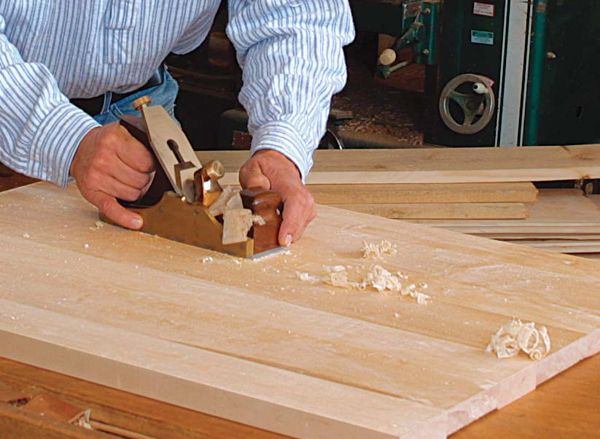Determining grain direction
Rules of Thumb: Understanding wood grain improves your success with hand and power tools
Synopsis: Furniture maker and author Chris Gochnour offers tips for reading the direction of the grain in a variety of wood species in this basic overview on the anatomy of rough lumber. His identification tips can improve your success when using hand and power tools and help prevent unwanted tearout. Gochnour also explores the science of a tree to illustrate how rays, vessels, and pores affect figure in a workpiece.
Wood’s beauty and appeal can be credited to the uniqueness and diversity of its grain. These same virtues, however, turn to vice when it comes to surfacing and smoothing lumber. The secret to achieving smooth surfaces with machine and hand tools is cutting in the direction of the grain. Sometimes grain can change direction on a single board. Depending on the species you’re working with, grain direction is not always obvious.
While you have a 50:50 chance of success by guessing which direction the grain runs, you can increase your odds greatly by studying a board for clues, listening and feeling as you mill the wood or work it by hand, and making midcourse corrections when necessary.
Rays, vessels, and figure are indicators
You can determine the grain orientation of various hardwoods by observing their physical characteristics. In some hardwoods, you can determine the grain direction by simply looking at the rays, which are wood cells that radiate from the center of a tree to its perimeter. They appear vividly in species such as oak, beech, and sycamore as dark, solid specs of varying lengths. Rays are visible on the surface of a plainsawn board in cross section, sandwiched between the fibers. Therefore, the long, narrow marks point in the same direction as the fibers, making them the most reliable indicator of the direction of the grain.
Rays can be difficult to make out on some species, in which case I look for vessels to determine grain direction. Vessels are wood cells that extend linearly in hardwood and appear most prominently in species such as mahogany, walnut, and butternut. They appear on the surface of the board as long, open tubes and on the end grain as small, open pores. Vessels align with the direction of the grain, so identifying the direction vessels travel also indicates the direction the grain travels.
Because many species display neither rays nor vessels to the naked eye, figure (which often is referred to as grain) is the last characteristic I look at to assess grain direction. Figure is created when the varying densities and color of the annular growth rings intersect with the surface of the board. On the face of a plainsawn board, figure often appears in cathedral patterns (see the photo at top right). Most of the time, figure will follow the grain, so it can be used as an indicator. However, it’s not uncommon for grain to run opposite the figure, so this isn’t always the most reliable source. In woods that don’t have prominent vessels or rays, such as cherry, maple, and alder, figure is the best characteristic to go by.
For the full article, download the PDF below:
Fine Woodworking Recommended Products

Starrett 12-in. combination square

Dubuque Clamp Works Bar Clamps - 4 pack

Bessey K-Body Parallel-Jaw Clamp























Log in or create an account to post a comment.
Sign up Log in